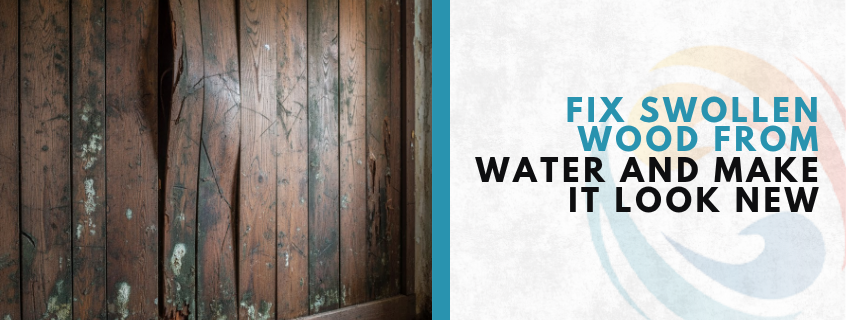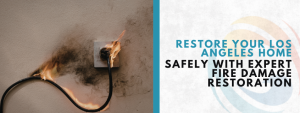Wooden furniture can transform a Santa Monica home with warmth and elegance, but water exposure can quickly ruin its charm. Moisture causes wood to swell, warp, or lose its finish, leaving your favorite pieces dull or uneven. The good news is you don’t need to replace them. By learning how to fix swollen wood from water, dry water-damaged wood, remove water stains from wood, and use proper refinishing techniques, you can restore its beauty.
Understanding Why Wood Swells from Water Damage
Wood swells when exposed to moisture, causing warping, bubbles, or soft spots. Understanding why this happens helps you fix swollen wood from water, including water extraction and drying, and prevent further damage.
Why Wood Reacts to Water
- Wood fibers naturally expand when they absorb moisture.
- Swelling can create raised or uneven surfaces, blisters under finishes, and soft spots.
Common Causes of Swollen Wood
- Spilled Liquids: Drinks, flower vases, or pet water bowls left on surfaces.
- High Humidity: Damp indoor air causes gradual wood expansion.
- Water Leaks: Pipes, roof leaks, or flooding that expose furniture to moisture.
- Improper Cleaning: Excessive water when wiping wood surfaces.
Knowing the cause is crucial before deciding on the best method to fix water-damaged wood and prevent future damage. Consulting local water damage restoration experts can help address the root cause and save furniture from recurring problems.
Step-by-Step Guide: How to Fix Swollen Wood from Water
Now that you know what you’re dealing with, let’s move on to the hands-on restoration process and learn how to effectively fix swollen wood from water.
1. Dry the Wood Thoroughly
Drying is the foundation of any successful repair. Moisture must be completely removed before refinishing or sealing.
- Place the furniture in a dry, airy space with good ventilation.
- Use fans to circulate air around the swollen areas.
- If possible, use a dehumidifier to speed up the process.
- Avoid direct sunlight or high heat sources; too much can crack or discolor the wood.
2. Release Trapped Moisture
If bubbles or raised patches appear, it’s a sign of trapped moisture beneath the surface. You can carefully draw this out using heat:
- Use a clothing iron on low heat with a dry towel between the iron and the wood.
- Glide gently over the area for a few seconds at a time.
- Alternatively, use a hairdryer on a low setting and keep it several inches away.
If bubbles remain, pierce them gently with a fine needle to release trapped air before drying again.
3. Sand the Damaged Surface
Once dry, it’s time to smooth the surface. Use sandpaper to remove the raised or uneven parts.
- Start with coarse-grit sandpaper (100–150 grit) to flatten swollen areas.
- Follow up with fine-grit sandpaper (220–300 grit) for a polished texture.
- Always sand in the direction of the grain to avoid scratches.
After sanding, wipe off all dust with a clean, dry cloth.
4. Refinish and Seal the Surface
After sanding, the surface will likely look dull or uneven in color. Refinishing restores its natural beauty.
- Wood stain (optional, for color matching)
- Protective wood sealant or varnish
- Soft cloth or foam brush
Apply thin layers of stain if needed, let it dry, and then seal it with a clear varnish or polyurethane finish. This prevents future moisture from seeping in again.
Protecting Your Furniture from Future Water Damage
You’ve worked hard to fix your furniture, and now it’s time to keep it safe for the long run. Regular maintenance and preventive care go a long way in avoiding another case of water damage, especially in Santa Monica, where coastal moisture can be a challenge, and can help remove water stains from wood. Start by applying furniture oil every few months to nourish the wood and create a strong moisture barrier. Always use coasters and placemats to protect against spills or heat marks, and keep furniture away from windows, damp corners, or humid areas. Adding felt pads under objects that rest on wooden surfaces also helps prevent scratches and trapped moisture.
Lastly, maintain ideal indoor humidity levels between 30% and 50% to keep your wood stable year-round. A home dehumidifier or air conditioner can help regulate moisture, ensuring your furniture stays in beautiful condition for years to come.
Quick Reference: Types of Wood Damage and Fixes
Understanding common water-related wood damage helps you choose the right repair method. This quick reference shows typical issues and practical solutions, including how to fix swollen wood from water, how to dry, restore, and protect water-damaged wood.
Common Issues and Solutions
- Swelling or Bulging: Caused by water absorption → Dry, sand, and refinish.
- White Rings or Spots: From heat or moisture → Use iron or polish carefully.
- Peeling Finish: Excess water exposure → Sand and reseal.
- Discoloration: Prolonged dampness → Stain and protect.
Pro Tips for Long-Term Care
- Wipe spills immediately.
- Reapply polish or wax monthly for protection.
- Inspect furniture seasonally for leaks, dampness, or humidity fluctuations.
Recommended products: Tung oil, polyurethane, and beeswax polish provide natural and lasting protection.
Reviving Wood Furniture After Water Damage
You can fix swollen particleboard furniture by drying it completely, sanding gently, and resealing, though severely damaged panels may need replacement. In Santa Monica, where coastal humidity can worsen swelling, wood generally takes 24 hours to several days to dry, depending on thickness and moisture levels; using fans or a dehumidifier can speed up the process. For bubbling veneer, press it down with a low-heat iron or inject adhesive under loose areas and clamp it flat. It’s safe to refinish once the wood is fully dry, feels even in color, and shows no cool spots. Avoid using household oils, and instead choose proper furniture oils like tung or mineral oil for lasting results.
How Professionals Restore Water-Damaged Wood
For severe cases of water damage, hiring local experts like Water Damage Restoration Santa Monica can make a significant difference. These professionals have the tools and experience to safely extract moisture from wood and surrounding areas, ensuring thorough drying without causing additional damage. They can also repair and refinish surfaces, sanding, staining, and sealing the wood to restore its original beauty. Persistent water stains that DIY methods often cannot fully remove are also treated with specialized techniques, bringing furniture back to its pre-damage condition.
Beyond immediate repairs, professional restoration services include preventive consultation to help Santa Monica homeowners maintain ideal humidity levels and protect wood furniture from future swelling or warping. Hiring experts is especially useful for delicate pieces, thick hardwood, or particleboard, where improper handling could worsen the damage. With professional restoration services, you gain not only a restored piece of furniture but also expert guidance on long-term care and protection.







